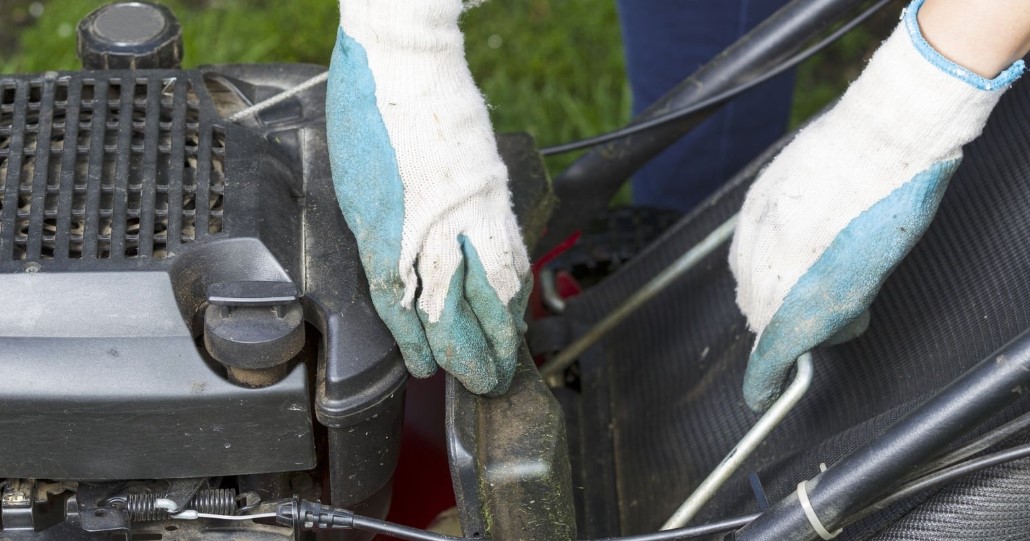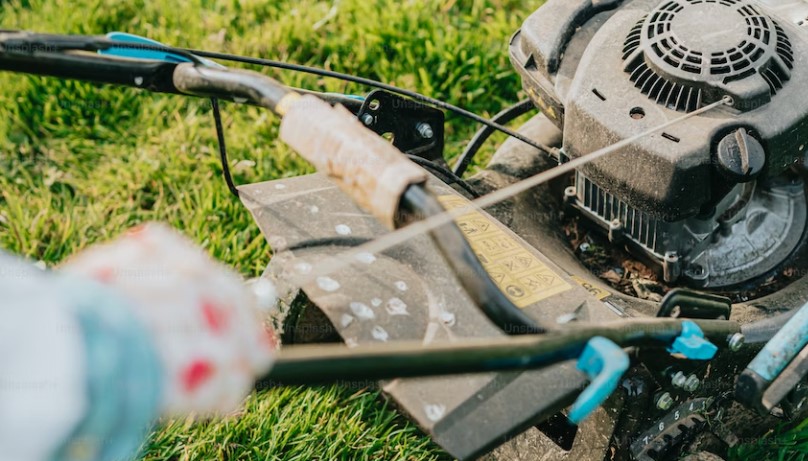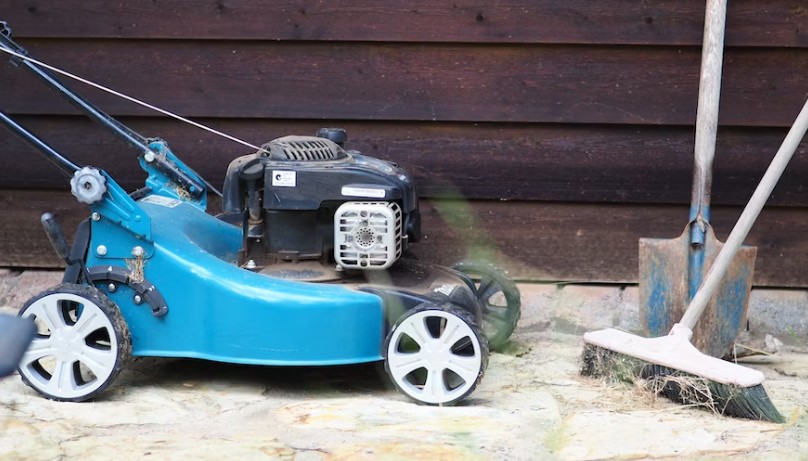How To Start A Lawn Mower: 4 Easy Steps
Maintaining a well-groomed lawn is a source of pride for many homeowners, and at the heart of this endeavor is a simple yet crucial task: starting your lawn mower. Whether you’re a novice in the world of lawn care or seeking a refresher, mastering the art of starting a lawn mower is your gateway to a lush and vibrant yard.
In this guide, we’ll give you a lead through how to start a lawn mower in 4 easy steps. By following these steps, you’ll be well on your way to a beautifully manicured lawn that stands as a testament to your dedication. Let’s dive in with BeBest and discover the straightforward process that will have your lawn mower up and running in no time.
Things to prepare when starting Lawn Mower
If you’re aiming for a hassle-free lawn mowing experience, it’s crucial to undertake a few essential preparations before firing up your lawn mower. These practical tips will help ensure that you’re all set for a successful mowing session:
Oil and Fuel Check: Ensuring Smooth Operation
Before you embark on your mowing endeavor, take a moment to inspect the oil level and the fuel tank of your lawn mower. Running out of gas mid-mow or subjecting your engine to potential damage due to low oil levels is a scenario best avoided. To guarantee an uninterrupted mowing session, make sure you have ample supplies of both oil and fuel to cover the entire lawn. If they’re running low, prioritize refilling them before commencing your mowing tasks.
Air Filter and Spark Plug Maintenance: Key to Efficiency
The air filter and spark plug are pivotal components of your lawn mower that wield a significant influence over its performance and overall efficiency. A clogged air filter can hamper proper airflow, causing your mower to work harder than necessary. Meanwhile, a deteriorated spark plug can result in misfires and inadequate ignition, ultimately affecting your mower’s functionality. Safeguard your mower’s efficiency by meticulously cleaning the air filter and spark plug. Gently remove them from the mower and use a soft brush or cloth to meticulously wipe away any accumulated dirt or debris.

Blade Sharpening: Elevating Cutting Precision
Guard against lackluster results by tending to your mower’s blades. Dull blades have the unfortunate tendency to tear the grass instead of delivering a clean, precise cut. This leaves your grass susceptible to various ailments and pest invasions. Counter this by ensuring your blades are properly sharpened. You have the option to take matters into your own hands, utilizing a file or grinder to sharpen the blades, or for optimal outcomes, consider entrusting this task to a seasoned professional.
Cutting Height Adjustment: Tailored to Perfection
Fine-tune your mowing strategy by adjusting the cutting height of your mower’s blades. This adjustment is especially significant based on the prevailing season and the specific type of grass gracing your lawn. In the warmer summer months, opting for a higher cutting height is beneficial, while lowering it during spring and fall is advisable. This strategic alteration encourages your grass to grow with greater vigor and resilience.
Additionally, it serves as a deterrent against weed proliferation. Achieve this adjustment by manipulating the lever or knob positioned conveniently on the side of your mower, allowing you to effortlessly set the desired cutting level.

How to Start a Lawn Mower
Starting a lawn mower is a straightforward process, but it’s important to follow the correct steps to ensure a smooth start and efficient operation. Here’s a concise guide to getting your lawn mower up and running:
Step 1: Check If Your Mower Has Gas and Oil
Before you embark on your lawn mowing task, it’s imperative to conduct a diligent check of your lawn mower’s fuel and oil levels. Neglecting this step could lead to inconvenient disruptions during your mowing session and, even worse, potential harm to the engine itself. A smoothly running engine relies on a consistent supply of both fuel and oil.
Step 2: Add Gas and Oil If Needed
If your scrutiny reveals that the levels of either gas or oil are running low, it’s essential to address this promptly. Taking a brief pause to refill the gas tank and oil reservoir is a small investment of time that pays off in uninterrupted and efficient mowing. Crucially, make certain that the type of gas and oil you use aligns with the manufacturer’s recommendations. This adherence to proper specifications is fundamental for ensuring your mower’s optimal performance and longevity.

Step 3: Prime the Engine
Modern lawn mowers often come equipped with a primer bulb, a nifty device designed to facilitate the starting process. To engage the primer bulb, simply give it a few deliberate presses. This seemingly minor action plays a significant role in drawing fuel into the carburetor. By doing so, you’re creating a favorable environment for ignition, making the subsequent starting process notably smoother.
Step 4: Pull the Starter Cord
With the preliminary steps completed, it’s now time to set the engine into motion. Grasp the handle of the starter cord firmly and execute a brisk pull. The technique you employ here might vary based on your specific mower model. Some mowers respond well to a fluid, consistent pulling motion, while others may require a quick, forceful tug. This pivotal action sets the engine in motion, kickstarting the ignition process that propels your mower into action.

What To Do If Your Lawn Mower Can NOT Start?
Dealing with a recalcitrant lawn mower that refuses to start can indeed be a source of frustration. But fret not! There’s a series of strategic steps you can undertake to diagnose and rectify the issue at hand. Let’s delve into this comprehensive troubleshooting guide designed to reignite the engine of your lawn mower:
Check Fuel and Oil Levels: Ensuring Vital Resources
Begin your troubleshooting journey by confirming that your lawn mower is adequately supplied with both fuel and oil. Inadequate levels of either can stymie the ignition process, causing undue hindrances. Should your inspection reveal any insufficiencies, take prompt action to replenish the fuel and oil reservoirs. Remember, utilizing the precise type of fuel and oil as stipulated by the manufacturer is pivotal for achieving peak performance.
Inspect the Spark Plug: Sparking Potential Back to Life
A beleaguered spark plug can cast a shadow over ignition efforts. Remove the spark plug and closely examine its condition. The presence of dirt or corrosion can impede the spark plug’s effectiveness. If such issues are detected, you have the choice to either meticulously clean the spark plug or replace it altogether with a fresh counterpart.

Examine the Air Filter: A Breath of Fresh Air
A clogged or soiled air filter can stifle airflow, disrupting combustion and impeding your mower’s starting process. To address this, gently remove the air filter and engage in a thorough cleaning regimen. Alternatively, opt for a seamless swap with a new filter to restore optimal airflow.
Check the Carburetor: Fuel Flow Restoration
A congested carburetor or the presence of residual old fuel can obstruct the smooth flow of fuel, disrupting ignition. Your best course of action here involves a comprehensive assessment of the carburetor. Consider embarking on a cleaning endeavor or, if necessary, a thorough overhaul to rectify any fuel flow hindrances.
Verify the Choke and Throttle: Precision in Positioning
Ensure that the choke and throttle settings align precisely with the manufacturer’s recommendations. The accurate positioning of these components is pivotal for a successful ignition attempt. Delve into your mower’s manual for precise insights into its proper configurations.
Inspect the Fuel Line: Uninterrupted Fuel Delivery
A fuel line marred by blockages or damage can hinder the seamless delivery of fuel to the engine. Undertake a meticulous inspection to detect any obstructions or leaks that might be impeding the fuel flow.
Prime the Engine: Fueling the Ignition Process
Should your mower be equipped with a primer bulb, capitalize on this feature to draw fuel into the carburetor, facilitating the ignition process.
Check for Spark: Illuminating Ignition
Remove the spark plug, reconnect it to the ignition wire, and establish a ground connection against the engine. Employ a firm pull of the starter cord while attentively observing for the telltale spark between the electrodes. In the absence of such a spark, the ignition system demands careful attention and potential intervention.

Clean the Carburetor Jet: Fluid Fuel Flow
Should suspicions of a clogged carburetor jet arise, exercise caution as you gingerly remove and subsequently cleanse it. Utilize carburetor cleaner or compressed air to meticulously restore fluid fuel flow.
Examine Safety Interlocks: Operational Vigilance
Many modern mowers incorporate safety interlocks that demand certain conditions be met prior to ignition. Scrutinize these interlocks, ensuring they are properly engaged and functioning as intended.
Fresh Fuel: A Renewed Source
Should the fuel within your mower exhibit signs of age or staleness, initiate a complete drainage of the old fuel, subsequently replenishing it with a fresh infusion of gasoline.
Professional Help: Seeking Expertise
In the event that your rigorous troubleshooting endeavors fail to yield the desired results, it may be time to solicit the assistance of a professional lawn mower technician. Their expertise can pinpoint and address issues that might elude a layperson’s assessment.
As you navigate this troubleshooting guide with precision and care, you’re taking proactive strides toward restoring your lawn mower’s vitality. Your persistence will undoubtedly pay off, ushering in the triumphant roar of a mower brought back to life and ready to tackle your lawn with renewed vigor.

Taking Care of Your Lawnmower
Your lawnmower, a steadfast partner in cultivating the verdant expanse of your yard, warrants your unwavering attention and care to ensure its peak performance. Through the diligent embrace of these foundational maintenance practices, you’re bestowing not only a lengthened existence upon your lawn mower but also inviting a consistent symphony of impressive outcomes:
Check the Motor Oil: A Prelude to Every Operation
As you prepare to embark on the artful choreography of lawn mowing, grant the motor oil level your undivided focus. This seemingly simple yet undeniably pivotal act stands as a guardian of the engine’s robust health and harmonious operation. With the practiced grace of a conductor, insert the dipstick into the oil reservoir and decipher the oil’s delicate dance within. The reading should align harmoniously with the manufacturer’s recommendation. Should the oil’s rhythmic pulse reveal a need for augmentation, tenderly administer the appropriate oil type until the reservoir breathes anew with vitality.
Insert the Dipstick: An Indicator of Vigor
Enveloped in the prelude of each mowing endeavor is the ceremonial act of the dipstick’s insertion into the oil chamber. This ritual, akin to a seasoned oracle’s pronouncement, unveils the oil’s narrative of readiness. The dipstick’s markings metamorphose into eloquent indicators, offering a profound glimpse into the engine’s essence. Armed with this insight, you’re poised to traverse your mowing odyssey with unwavering assurance.

Maintain Your Lawn Mower: A Mark of Diligence
Inscribed in the annals of effective lawnmower care is the unwavering commitment to its perpetual upkeep. Engage in a choreographed symphony of routine inspections, where each component takes center stage for its moment under the spotlight. A discerning eye identifies signs of wear, the marks of damage, and the whispered tales of debris accumulation. Swift and deliberate actions follow whether it entails the tender embrace of tightened parts, the cleansing ritual bestowed upon the undercarriage, or the transformative exchange of weary components. This nurturing engagement, a testament to your diligence, unfurls a tapestry of lasting efficiency and prolonged existence.
Fill the Gas Tank: Powering the Performance
Fueling the heart of your lawnmower’s performance lies an act of nurturing that extends to the gas tank. It demands your undivided attention, a measure of liquid sustenance that propels the symphony of blades and wheels into motion. As you step onto the stage of each mowing venture, ensure the gas tank stands as a reservoir of abundant potential. Its levels brimming with the appropriate elixir, this act of preparation renders your lawnmower poised for a seamless, uninterrupted performance.
FAQs
What Should I Do If the Gas Line Is Clogged?
You may need to clean or replace the gas line if it is blocked. To remove any debris, you might try unplugging the gas line from the carburetor and blowing air through it. If that doesn’t work, a new gas line could be necessary. Before doing this, be sure to close the fuel valve and empty the gas tank.
What Should I Do If the Handle Has No Resistance When Starting?
The starter rope or the recoil spring may malfunction if the handle initiates with little resistance. The starting rope can be pulled out to see if it retracts smoothly. If not, you might have to swap either the spring or the rope. They are available online or at your neighborhood hardware shop. When removing the starter housing, exercise caution since the spring might come out and hurt you.

What Causes the “Ting” Noise My Lawn Mower Makes When I Try to Start It?
A loose or broken spark plug may be the cause of the “ting” sound your lawn mower makes when you try to start it. By taking out the spark plug, you may examine for cracks, corrosion, or carbon buildup. Holding the plug against a metal component of the engine while drawing the starting rope is another way to check the spark. A blue spark ought to be seen between the electrodes. If not, a new spark plug could be required. Use the appropriate size and kind for your particular model of lawn mower.
Conclusion
After reading about how to start a lawn mower in 4 easy steps in this article, you can now relish the advantages of possessing a well-maintained lawn and garden. You are now prepared to cut your grass expertly. Besides, it’s important to remember to adhere to the safety precautions and don appropriate protective gear when operating the lawn mower. Embrace the joy of the mowing experience!
Related Articles